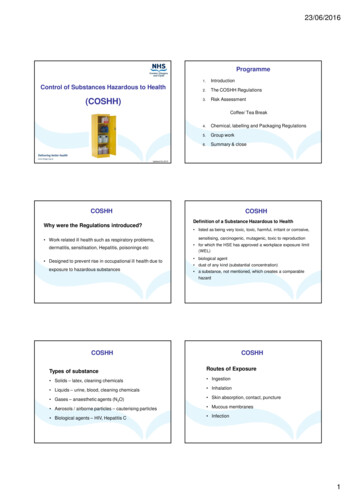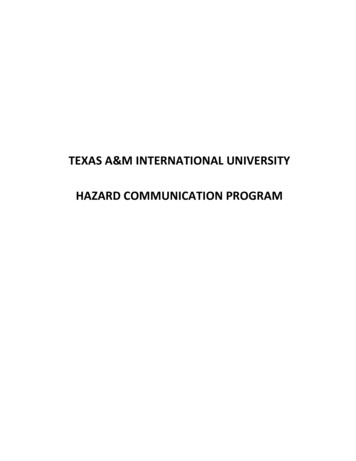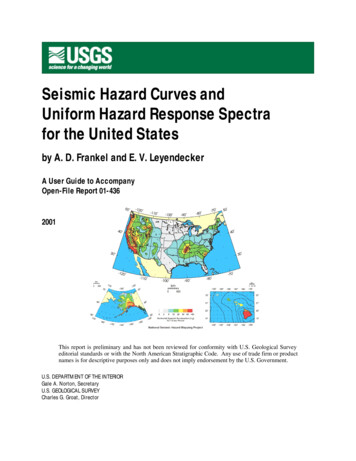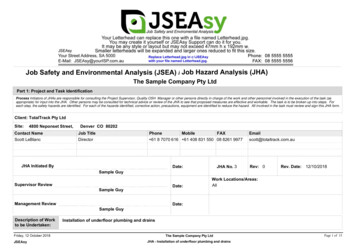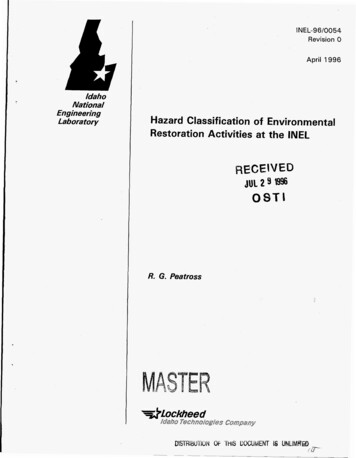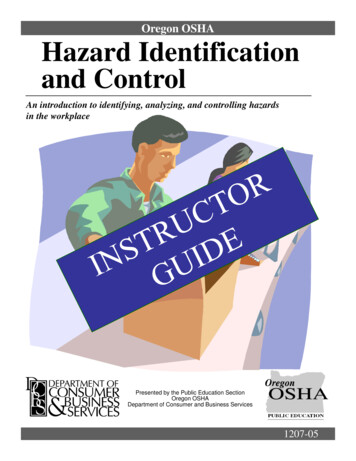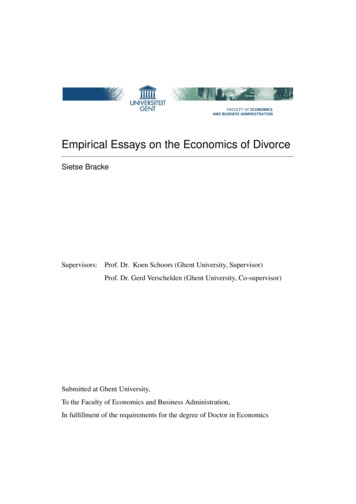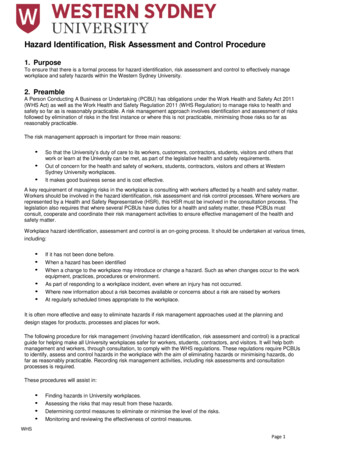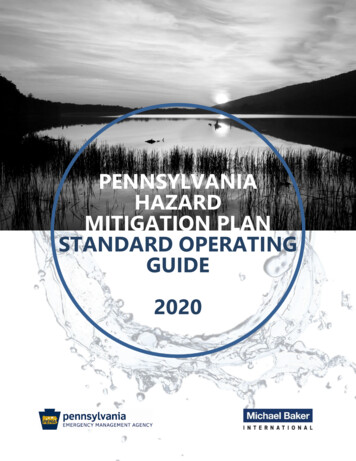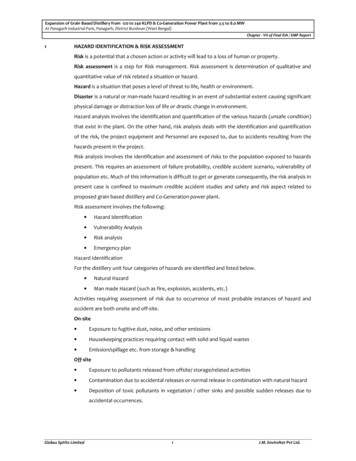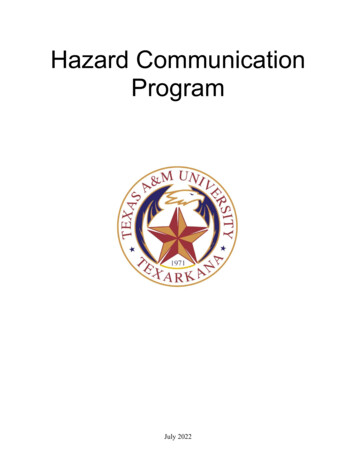
Transcription
Hazard CommunicationProgramJuly 2022
INTRODUCTIONThe Texas Hazard Communication Act requires public employers to inform employees about chemicalsthey may use or be exposed to in the workplace. All employees have a right to know what hazardouschemicals are in the workplace and how those chemicals could affect their health. Employees also have theright to file complaints for violations of the Act without fear of being harassed, disciplined, or terminated. Inorder to ensure Texas A&M University-Texarkana employees are provided with this information, we havedeveloped this Hazard Communication Program.1. CHEMICAL INVENTORY AND SAFETY DATA SHEETSThe definition of a chemical in the Hazard Communication Standard (HCS) is much broader than that whichis commonly used. The HCS definition of chemical is "any element, chemical compound, or mixture ofelements and/or compounds." Thus, virtually any product is a "chemical." These various types of chemicalsare as follows:1.1Element - the simplest form of matter. There are currently 118 known elements in the periodic table.Examples of elements are aluminum, carbon, chlorine, hydrogen, mercury, and oxygen1.2 Chemical compound - a substance consisting of two or more elements combined or bonded together sothat its constituent elements are always present in the same proportions1.3 Mixture - any combination of two or more chemicals if the combination is not, in whole or in part, theresult of a chemical reactionAlthough virtually all materials are considered chemicals under this definition, the HCS identifies certaincategories of chemicals that are not covered by the standard. These categories are:1.41.51.61.71.81.91.10Any hazardous waste as defined by the Solid Waste Disposal Act when subject to regulations issuedunder that Act by the Environmental Protection Agency;Any hazardous substance as defined by the Comprehensive Environmental Response, Compensationand Liability Act when the hazardous substance is the focus of remedial or removal action beingconducted under that Act in accordance with Environmental Protection Agency regulations;Tobacco or tobacco products;Wood or wood products, including lumber which will not be processed, where the chemicalmanufacturer or importer can establish that the only hazard they pose to employees is the potential forflammability or combustibility (wood or wood products which have been treated with a hazardouschemical covered by this standard, and wood which may be subsequently sawed or cut, generatingdust, are not exempted);Articles, defined as a manufactured item other than a fluid or particle: (i) which is formed to a specificshape or design during manufacture; (ii) which has end use function(s) dependent in whole or in partupon its shape or design during end use; and (iii) which under normal conditions of use does notrelease more than very small quantities, e.g., minute or trace amounts of a hazardous chemical, anddoes not pose a physical hazard or health risk to employees;Food or alcoholic beverages which are sold, used, or prepared in a retail establishment (such as agrocery store, restaurant, or drinking place), and foods intended for personal consumption byemployees while in the workplace;Any drug, as that term is defined in the Federal Food, Drug, and Cosmetic Act, when it is in solid,final form for direct administration to the patient (e.g., tablets or pills); drugs which are packaged bythe chemical manufacturer for sale to consumers in a retail establishment (e.g. , over-the-counterdrugs); and drugs intended for personal consumption by employees while in the workplace (e.g. , firstaid supplies);1
1.11 Cosmetics which are packaged for sale to consumers in a retail establishment, and cosmetics intendedfor personal consumption by employees while in the workplace;1.12 Any consumer product or hazardous substance, as those terms are defined in the Consumer ProductSafety Act and Federal Hazardous Substances Act, respectively, where the employer can show that itis used in the workplace for the purpose intended by the chemical manufacturer or importer of theproduct, and the use results in a duration and frequency of exposure which is not greater than the rangeof exposures that could reasonably be experienced by consumers when used for the purpose intended;1.13 Nuisance particulates where the chemical manufacturer or importer can establish that they do not poseany physical or health hazard covered under this section;1.14 Ionizing and nonionizing radiation; and1.15 Biological hazards.Each work area at A&M-Texarkana where chemicals are used or stored will have a binder containing achemical inventory list and a Safety Data Sheet (SDS) for each corresponding chemical. The SDS willprovide employees with specific information on chemicals they use. The Environmental, Health & SafetyManager (EHS) and Laboratory Coordinators will perform an inventory inspection once a year. No newchemical will be introduced at A&M-Texarkana without first obtaining an SDS for that chemical. A masterlist of all chemicals and their SDS will be located electronic and can be viewed by contacting EHS and/or alaboratory coordinator. Employees may access the SDS anytime the university is open or they can find theappropriate SDS at each work area where chemicals are used or stored. If an SDS cannot be located for acertain chemical, the employee can call the chemical manufacturer and request a copy of the SDS, check theinternet for the SDS using the links provided on the A&M-Texarkana EHS Web page, or contact the EHSOffice.2. LABELS2.1 Permanent Container LabelsEmployees of A&M-Texarkana will not use, store, or allow any other person to use or store anyhazardous substance on campus if the container (including bags, barrels, bottles, boxes, cans, cylinders,drums, and reaction vessels) does not meet the following labeling requirements in OSHA’s HazardCommunication Standard [29 CFR 1910.1200(f)(1)]:2.1.1 Product Identifier – Same as product identifier on SDS;2.1.2 Pictograms – Black hazard symbol on white background with red diamond border;2.1.3 Signal Word – Either ‘Danger’ or ‘Warning’ as determined by severity;2.1.4 Hazard Statement(s) – Describes the nature and/or degree of the hazard(s);2.1.5 Precautionary Statement(s) – Prevention, response, storage, and spill measures; and2.1.6 Supplier information – Including name, address, and phone number.2.2 Portable (Secondary) Container LabelsOften, laboratory operations require transferring chemicals from the original labeled container into asecondary container (e.g., beaker, flask, or bottle). Portable containers must comply with the labelingrequirements listed above if any of the following events occur:2.2.1 The material is not used within the work shift of the individual who makes the transfer.2.2.2 The worker who made the transfer leaves the work area.2.2.3 The container is moved to another work area and is no longer in the possession of the workerwho filled the container.Workplace labels do not require a red diamond border and may instead have a black border.Labels must be in English; other languages are permitted in addition to that.2
Labels on portable containers are not required if the worker who made the transfer uses all of thecontents during the work shift.When a secondary container is used for longer than one shift or does not meet the requirements outlinedin the Permanent Container Labels section above, a label needs to be applied to the secondary container.This label must contain three key pieces of information: the name of the chemical(s) in the container(e.g., product identifier), the hazards present (listed in words, pictures, symbols, or combinationthereof), and the date of transfer. The laboratory coordinators are responsible for ensuring that allsecondary containers are properly labeled.2.3 Replacement Container LabelThe existing label on a container entering the workplace from a supplier must not be removed, altered,or defaced. If a chemical container’s original label must be replaced, the new label must contain thesame information as the original. Only use labels, ink, and marking that are not soluble in the liquidcontent of the container.2.4 Exemptions to labeling requirements include food, drugs, pesticides, cosmetics, distilled spirits andconsumer products labeled in accordance with the Consumer Product Safety Act.3. PERSONAL PROTECTIVE EQUIPMENTA&M-Texarkana will do everything possible to lessen or prevent exposure to hazardous chemicals throughthe use of control/work practices and personal protective equipment (PPE). Personal protective equipment isprovided for all employees. When employees are required to wear PPE, they will do so. The use of PPE isnot a choice. It is mandatory to protect the employee’s health and safety.3.1 Listed below are specific instances where employees are required to wear PPE:3.1.1 Groundskeeper: When working with any pesticide, employee shall wear impervious gloves,goggles and a dust mask.3.1.2 Maintenance: When working with any corrosive chemicals, such as heavy-duty floorstripper, employees shall wear goggles and impervious gloves.3.1.3 Housekeeping: When working with any corrosive chemicals used for cleaning, such as toiletbowl cleaners and tub and tile cleaners, employees shall wear goggles and imperviousgloves.3.2 Employees will wear impervious gloves when using ANY CHEMICAL, no matter the level of hazard.4. TRAININGNew employees who have the potential for exposure to hazardous chemicals will attend hazardcommunication training before performing functions which may cause exposure. This would also includeany personnel who have never had chemical safety training.4.1 Training topics will include:4.1.1 Interpreting labels, understanding an SDS, and how to obtain more information;4.1.2 Location of work area chemical lists and SDSs;4.1.3 Hazards associated with each chemical group;4.1.4 First-aid treatment;4.1.5 Safe methods of handling hazardous chemicals;4.1.6 Proper storage of hazardous chemicals;4.1.7 Instructions on spill clean-up and disposal of hazardous chemicals;4.1.8 Acute and chronic effects of chemicals; and3
4.1.9Identify the need for and proper use of personal protective equipment.5. OUTSIDE CONTRACTOR RESPONSIBILITIESWhenever an outside contractor brings a hazardous substance onto A&M-Texarkana property, the contractorshall furnish an SDS for that substance. Service contractors whose work or materials pose a health hazard toemployees shall be responsible for the training required as outlined under the training section of this policy.6. NON-ROUTINE TASKSBefore any employee is required to perform a hazardous nonroutine task, a special training session will beconducted to inform them about the hazardous chemicals to which they may be exposed and the properprecautions to take to reduce or avoid the risk of exposure.7. DUTIES AND RESPONSIBILITIESHazard communication compliance will fall under the responsibility of the EHS. The EHS Office willmaintain liaison with the A&M System Assistant Director of Environmental Health and Safety and theTexas Department of Health to stay abreast of all modifications and changes to the A&M System and theState of Texas rules and regulations pertaining to hazard communications.7.1 Environmental Health & Safety Manager shall:7.1.1Post official “Notice to Employees” at regular posting areas throughout the campus and allwork areas where hazardous materials are stored. This notice advises employees of theirrights pertaining to hazardous chemicals used in the workplace.7.1.2 Compile, provide, and maintain for 30 years, a designated workplace chemical inventory list.7.1.3 Provide hazardous material training to all employees who use or handle hazardous chemicals.Training shall include the location and use of SDS, interpreting labels, generic informationon hazardous chemicals, the use of personal protective equipment, first aid treatment, generalinstructions on spill cleanup procedures, and work area specific training to employees whohandle hazardous material.7.1.47.1.57.1.67.1.7Compile and maintain a collection of Safety Data Sheets for all chemicals on hand at A&MTexarkana.Post SDSs in all work areas where hazardous materials are kept.Ensure all laboratory personnel have received appropriate training and are training theirstudents in the safe handling and use of chemicals.Maintain employee training records for 5 years.8. REPORTINGIn the event an accident occurs where hazardous chemicals are involved, either directly or indirectly, andone (1) or more employees are fatally injured or five (5) or more employees are hospitalized, the EHSManager shall notify the Texas Department Of Health as soon as practical by telephone. Written notificationwill follow within 48 hours of the incident giving the specific details of the incident.If any employee sees any hazardous chemical being used or stored in an unsafe manner, it shall be their dutyto report the incident to the EHS Office as soon as possible. The EHS Office shall ensure that the problemor practice is corrected as soon as possible. No employee shall be discriminated against or disciplined in anyway for reporting any hazardous chemical problem locally, to the Texas Department of Health, or otherappropriate agency.4
The Texas Hazard Communication Act requires public employers to inform employees about chemicals they may use or be exposed to in the workplace. All employees have a right to know what hazardous chemicals are in the workplace and how those chemicals could affect their health. Employees also have the

